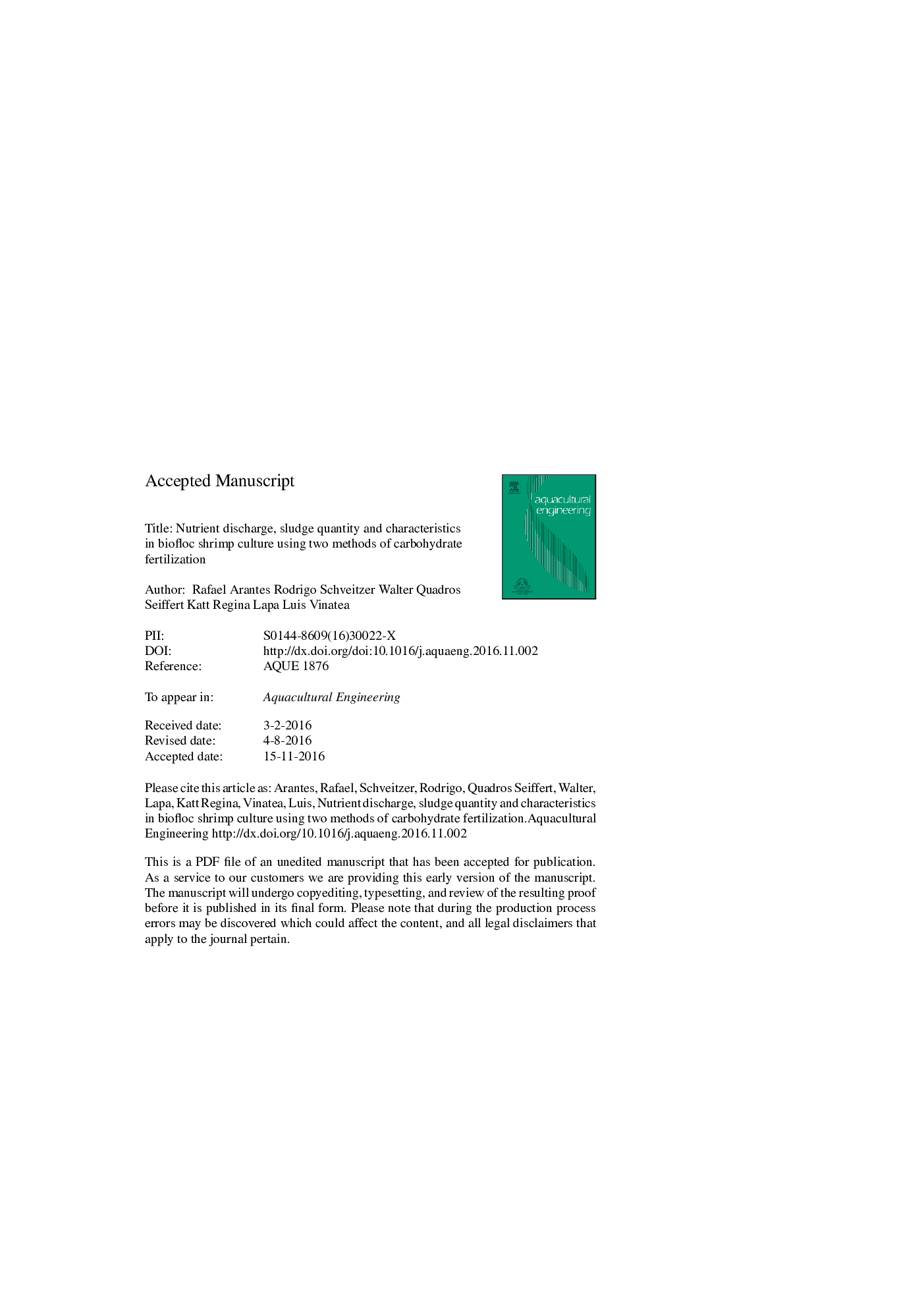| کد مقاله | کد نشریه | سال انتشار | مقاله انگلیسی | نسخه تمام متن |
|---|---|---|---|---|
| 5763951 | 1625695 | 2017 | 36 صفحه PDF | دانلود رایگان |
عنوان انگلیسی مقاله ISI
Nutrient discharge, sludge quantity and characteristics in biofloc shrimp culture using two methods of carbohydrate fertilization
ترجمه فارسی عنوان
ترشحات غذایی، مقدار و خصوصیات لجن در فرهنگ میگو بیولوژیکی با استفاده از دو روش کودی کربوهیدرات
دانلود مقاله + سفارش ترجمه
دانلود مقاله ISI انگلیسی
رایگان برای ایرانیان
کلمات کلیدی
موضوعات مرتبط
علوم زیستی و بیوفناوری
علوم کشاورزی و بیولوژیک
علوم آبزیان
چکیده انگلیسی
The aim of this study was to evaluate the effect of two methodologies of carbohydrate fertilization on the volume and characteristics of effluent from intensive biofloc shrimp cultivation. Six fiberglass circular tanks (50 m2 each) were divided into two treatments. In the treatment called continuous (CONT), the tanks received daily molasses fertilization throughout the entire rearing period. In the treatment named initial (INI), molasses was used only in the early weeks of cultivation. Juvenile Litopenaeus vannamei (0.87 ± 0.10 g) were stocked at a density of 180 animals mâ2 and cultured during 12 weeks until they reached an average weight of 12 g. The tanks were operated with no water exchange and the total suspended solids concentration were kept between 300 and 400 mg Lâ1 using settling chambers. The sludge produced and the wastewater at harvest were quantified and their characteristics were determined. The production of TSS in the CONT treatment was higher (0.25 kg of solids per kg of applied feed) than in the INI treatment (0.16 kg kgâ1) (P < 0.05). The analysis of the sludge revealed a high amount of volatile solids in both treatments, between 636 and 702 g kgâ1. However, due to the elevated sludge nitrogen content, the carbon to nitrogen (C:N) ratio was low, with values of 6.4 ± 1.4 and 7.5 ± 1.6 for INI and CONT respectively. The BOD:TSS ratio was also low in both treatments, but the INI showed lower values (10.3 ± 0.6%) than the CONT (14.9 ± 0.0%) (P < 0.05). Both fertilization strategies were able to modify the characteristics of sludge produced during cultivation. Moreover, the high nitrogen and sulfate content of the sludge in both treatments indicated that it may be difficult to use an anaerobic digestion process to treat sludge. In the INI treatment tanks, the sludge is partially stabilized, while in the CONT there was a greater need for stabilization.
ناشر
Database: Elsevier - ScienceDirect (ساینس دایرکت)
Journal: Aquacultural Engineering - Volume 76, January 2017, Pages 1-8
Journal: Aquacultural Engineering - Volume 76, January 2017, Pages 1-8
نویسندگان
Rafael Arantes, Rodrigo Schveitzer, Walter Quadros Seiffert, Katt Regina Lapa, Luis Vinatea,
